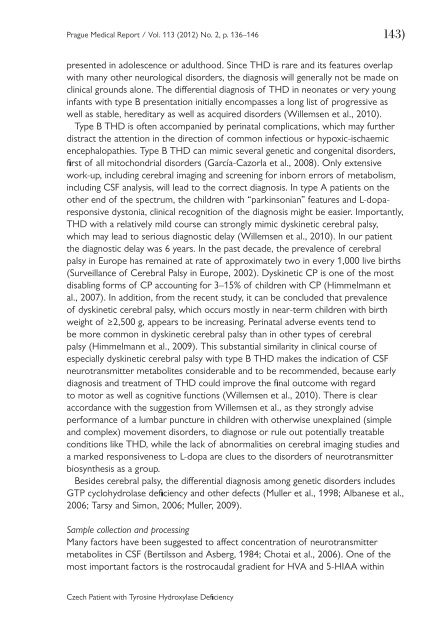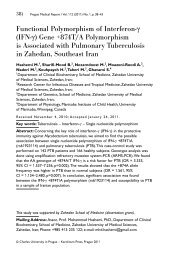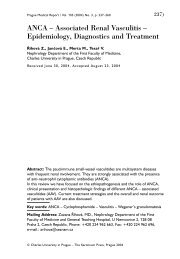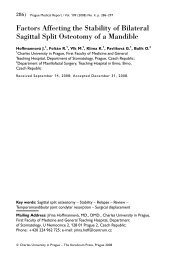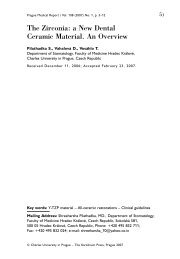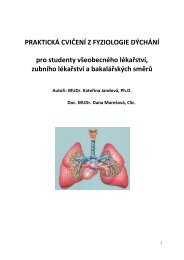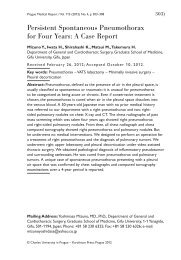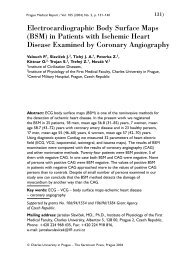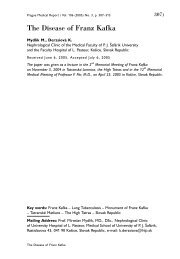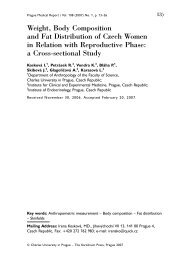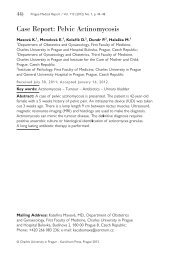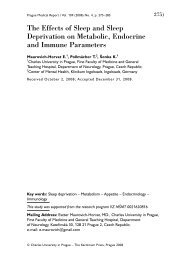(PDF). - Prague Medical Report
(PDF). - Prague Medical Report
(PDF). - Prague Medical Report
You also want an ePaper? Increase the reach of your titles
YUMPU automatically turns print PDFs into web optimized ePapers that Google loves.
<strong>Prague</strong> <strong>Medical</strong> <strong>Report</strong> / Vol. 113 (2012) No. 2, p. 136–146<br />
143)<br />
presented in adolescence or adulthood. Since THD is rare and its features overlap<br />
with many other neurological disorders, the diagnosis will generally not be made on<br />
clinical grounds alone. The differential diagnosis of THD in neonates or very young<br />
infants with type B presentation initially encompasses a long list of progressive as<br />
well as stable, hereditary as well as acquired disorders (Willemsen et al., 2010).<br />
Type B THD is often accompanied by perinatal complications, which may further<br />
distract the attention in the direction of common infectious or hypoxic-ischaemic<br />
encephalopathies. Type B THD can mimic several genetic and congenital disorders,<br />
first of all mitochondrial disorders (García-Cazorla et al., 2008). Only extensive<br />
work-up, including cerebral imaging and screening for inborn errors of metabolism,<br />
including CSF analysis, will lead to the correct diagnosis. In type A patients on the<br />
other end of the spectrum, the children with “parkinsonian” features and L-doparesponsive<br />
dystonia, clinical recognition of the diagnosis might be easier. Importantly,<br />
THD with a relatively mild course can strongly mimic dyskinetic cerebral palsy,<br />
which may lead to serious diagnostic delay (Willemsen et al., 2010). In our patient<br />
the diagnostic delay was 6 years. In the past decade, the prevalence of cerebral<br />
palsy in Europe has remained at rate of approximately two in every 1,000 live births<br />
(Surveillance of Cerebral Palsy in Europe, 2002). Dyskinetic CP is one of the most<br />
disabling forms of CP accounting for 3–15% of children with CP (Himmelmann et<br />
al., 2007). In addition, from the recent study, it can be concluded that prevalence<br />
of dyskinetic cerebral palsy, which occurs mostly in near-term children with birth<br />
weight of ≥2,500 g, appears to be increasing. Perinatal adverse events tend to<br />
be more common in dyskinetic cerebral palsy than in other types of cerebral<br />
palsy (Himmelmann et al., 2009). This substantial similarity in clinical course of<br />
especially dyskinetic cerebral palsy with type B THD makes the indication of CSF<br />
neurotransmitter metabolites considerable and to be recommended, because early<br />
diagnosis and treatment of THD could improve the final outcome with regard<br />
to motor as well as cognitive functions (Willemsen et al., 2010). There is clear<br />
accordance with the suggestion from Willemsen et al., as they strongly advise<br />
performance of a lumbar puncture in children with otherwise unexplained (simple<br />
and complex) movement disorders, to diagnose or rule out potentially treatable<br />
conditions like THD, while the lack of abnormalities on cerebral imaging studies and<br />
a marked responsiveness to L-dopa are clues to the disorders of neurotransmitter<br />
biosynthesis as a group.<br />
Besides cerebral palsy, the differential diagnosis among genetic disorders includes<br />
GTP cyclohydrolase deficiency and other defects (Muller et al., 1998; Albanese et al.,<br />
2006; Tarsy and Simon, 2006; Muller, 2009).<br />
Sample collection and processing<br />
Many factors have been suggested to affect concentration of neurotransmitter<br />
metabolites in CSF (Bertilsson and Asberg, 1984; Chotai et al., 2006). One of the<br />
most important factors is the rostrocaudal gradient for HVA and 5-HIAA within<br />
Czech Patient with Tyrosine Hydroxylase Deficiency


